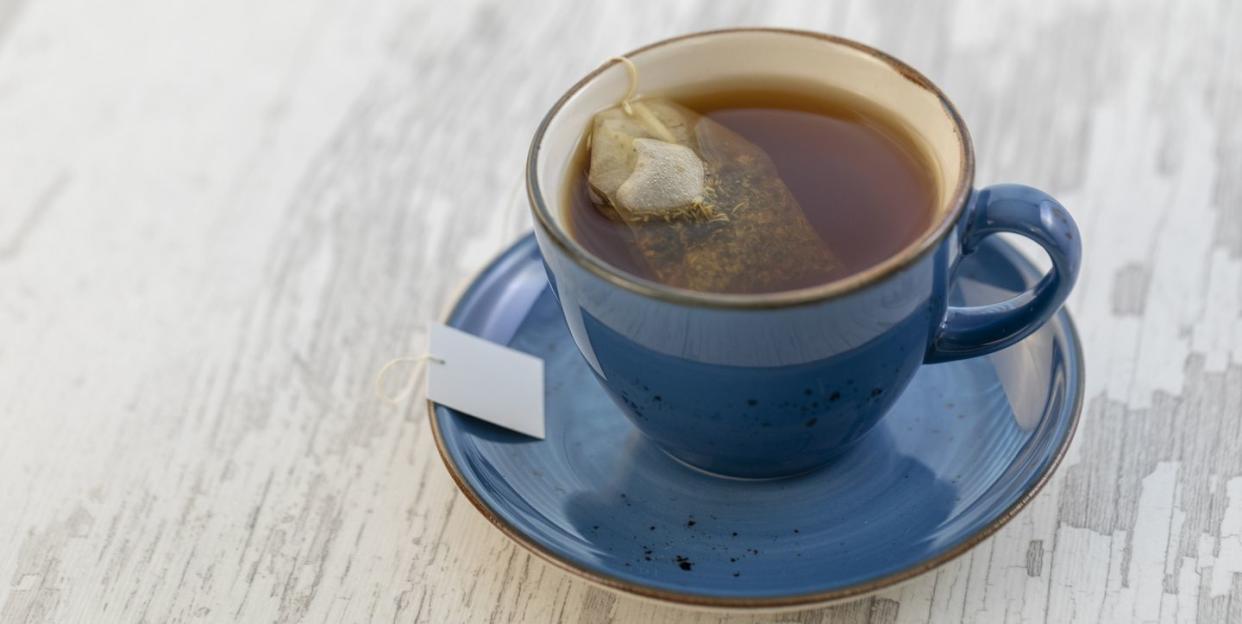Brewing the Perfect Cup of Tea Depends on How You Steep It, According to Science

"Hearst Magazines and Yahoo may earn commission or revenue on some items through the links below."
A 2021 study explains why your cup of tea sometimes ends up with a nasty film of scum on the top.
This so-called “tea scum” is the result of a chemical reaction between the natural plant compounds in tea, called polyphenols, and calcium carbonate.
Use a squeeze of lemon to reduce or eliminate the film.
Next to water, tea is the most-consumed beverage in the world. Globally, we sip about 3.7 billion cups of tea per day, the continuation of a 4,000-year-old Chinese tradition. And, for cyclists, there are many benefits to drinking tea. The most important being hydration, however, its also rich in antioxidants that are good for your brain health and heart health, and reducing your risk of inflammation and chronic diseases. But for as long as humans have been drinking tea, they’ve also been arguing over the best way to brew it.
Lu Yu, a Chinese monk who would go on to become the “Sage of Tea,” published the first tea tutorial in the year 792. Cha Jing, or The Classic of Tea, is a 10-chapter treatise on the cultivation, preparation, and enjoyment of tea that covered everything from the best soil for growing tea leaves to poems about the steamy beverage.
Since then, tea primers have come in the form of books and studies, as well as the diatribes of famous British men, including John Lennon, Douglas Adams, and George Orwell, the latter of which shared some very strong opinions about the matter in his essay “A Nice Cup of Tea.” “How can you call yourself a true tea-lover if you destroy the flavor of your tea by putting sugar in it?” Orwell writes. “It would be equally reasonable to put in pepper or salt.”
Earlier this fall, researchers at the Institute of Food Nutrition and Health in Zürich, Switzerland added to this tome of tea-related literature with a 2021 study published in the journal Physics of Fluids. It details the cause of that greasy film that forms on the surface of a mug of black tea—colloquially known as tea scum—and how to prevent it.
The work was a detour for co-author and doctoral candidate Caroline Giacomin, Ph.D. (c), who typically studies how different particles affect the mucus in our bodies. When COVID-19 made sourcing mucus for her lab work impossible, Giacomin found inspiration in her daily cup of tea and the tea scum that came with it.
Scientists have been trying to get to the bottom of the tea scum debate for decades, Giacomin explains. In the early 1990s, a study debunked a myth that the scum was the result of waxy residue on tea leaves. Instead, they discovered, the film resulted from a reaction between the natural plant compounds in tea called polyphenols and calcium carbonate (the primary component of hard water, which has a high mineral content).
With the chemical composition of tea scum nailed down, Giacomin wanted to look at its physical properties, including thickness and resistance, details that might prove useful not just for at-home tea connoisseurs, but also for commercial producers of tea, such as those that sell bottles of (preferably scum-free) iced tea.
To do so, the researchers turned to the science of interfacial rheology, a branch of fluid dynamics (the study of fluids and how different forces affect them) that focuses on the behavior of matter when a gas and a liquid meet—in this case, the interface of the air and steeped black tea. In their experiment, the scientists slowly rotated a motorized metal disk, called a rheometer, on the surface of a mug of loose-leaf Ceylon black tea in order to measure the strength and thickness of the film depending on water hardness, as well as common tea additions like lemon, sugar, and milk.
Water hardness had the most demonstrative effect on the development of tea scum: The harder the water, the stronger the film (your local public works department should be able to tell you how hard your water is, and at-home tests are inexpensive and readily available online). Sugar didn’t appear to influence tea scum; milk contributes to its thickness, while the acidity of lemon can reduce or even prevent it.
Giacomin is stuck with Zurich’s very hard water for her tea, but drinks Earl Grey—made with Bergamot citrus oil—to reduce the scum in her mug.
Beyond scum, additional recent studies turn up some useful tips for brewing the best possible tea.
How long you steep your tea, for example, can impact its antioxidant properties. If you’re trying to choose between loose-leaf or bagged tea, another study from 2019 revealed that plastic tea bags may shed micro- and nano-sized plastic bits, which are potentially harmful to the environment and your body. If you’re a tea drinker who nukes your water, you may want to reconsider: microwaves heat liquid unevenly, causing hot water to remain at the surface, with cooler water down below.
Perhaps the finest, most comprehensive guide came from England’s Royal Society of Chemistry in 2003. In a press release, the organization lays out the tea-making process in meticulous detail, from how long to steep (three minutes) to what mug to use (your favorite, obviously).
On the topic of tea scum, the guide advises using softened, filtered water, and, despite Orwell’s plea to tea drinkers, suggests that sugar is a fine additive to counteract the natural astringency of tea. (Just remember, the American Heart Association recommends consuming no more than 6 teaspoons of added sugar per day for women and no more than 9 teaspoons a day for men.)
You Might Also Like

